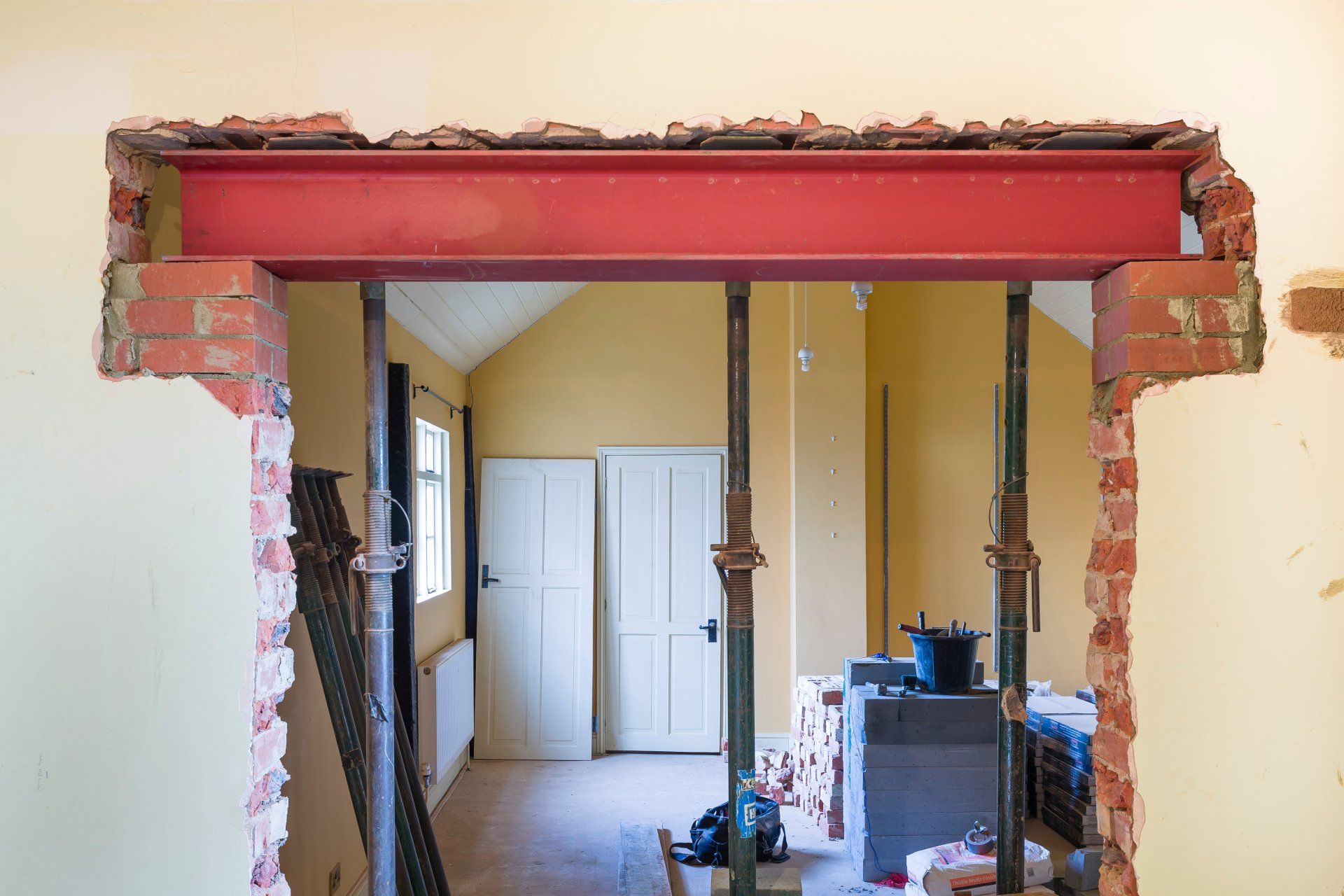How to Tell if a Wall is Load-Bearing in a Perth Home
A practical guide for Perth homeowners to identify load-bearing walls, avoid costly mistakes, and create safe open-plan living spaces.
Introduction
Open-plan living is one of the biggest renovation trends across Perth. Knocking down a wall to connect your kitchen, dining and living areas can completely transform the way you use your home — letting in more natural light, improving airflow, and creating that modern, spacious feel.
But before you even think about picking up a sledgehammer, there’s a crucial question to answer: is that wall load-bearing?
Understanding which walls hold up your roof or upper storey is critical. Removing the wrong wall without proper planning and support can cause serious structural damage. This guide will walk you through the basics of spotting load-bearing walls in Perth homes, when to bring in a professional, and what to expect if you’re planning wall removal.
What Does “Load-Bearing” Mean?
A load-bearing wall is a wall that carries the weight of the structure above it — roof trusses, beams, upper floors, or even additional walls. Removing it means that weight has to be transferred elsewhere, usually via a structural steel beam or lintel.
By contrast, non-load-bearing walls (sometimes called partition walls) are there to divide rooms, provide privacy, or support fixtures, but they aren’t holding up your roof or second storey.
Why It Matters in Perth Homes
Homes in Perth come in many construction styles — double brick, brick veneer, timber-framed roofs, and increasingly steel truss systems in new builds. The style of construction heavily influences how loads are transferred:
- Double brick homes (common pre-1990s): Internal brick walls often take loads directly from the roof.
- Brick veneer / timber frame (more recent builds): Loads are generally carried by the external frame and strategically placed structural walls inside.
- Two-storey homes: Internal walls are more likely to be load-bearing because they support the upper level.
Because of this variety, what looks like a simple wall might be essential to the structure.
Signs a Wall May Be Load-Bearing
Here are the most common indicators to look for:
1. Position in the House
- Walls that run perpendicular to ceiling joists or roof trusses are more likely to be load-bearing.
- Central walls, particularly those running down the middle of the home, often carry structural loads.
- In two-storey homes, walls directly beneath upper walls almost always provide support.
2. Thickness and Material
- In older double-brick homes, thicker internal brick walls usually carry load.
- In newer homes, even timber stud walls can be load-bearing if they align with the roof structure.
3. Connection Points
- Walls that line up with beams or intersect with other structural walls are usually part of the load-bearing network.
- Check in the roof space: if rafters, trusses or beams rest on that wall, it’s almost certainly structural.
4. Foundation Clues
- If the wall sits on a concrete footing or has a visible foundation line, it was likely designed to carry weight.
When It’s Not Load-Bearing
Partition walls are common in kitchens, hallways and bathrooms — they divide space but don’t support anything above. Clues include:
- Walls that run parallel to joists/trusses.
- Stud walls that feel lighter when tapped.
- Internal walls in newer homes that don’t align with roof support points.
Can You Tell for Sure Without a Professional?
You can often make an educated guess based on the clues above, but only a qualified builder or structural engineer can confirm with certainty. Perth homes have quirks — hidden beams, unconventional renovations, or extensions done decades ago — that make DIY assessments risky.
A professional inspection usually costs only a fraction of what mistakes would. More importantly, councils in WA require engineering approval before removing a load-bearing wall, so confirmation is unavoidable if you’re serious about the project.
What Happens if You Remove a Load-Bearing Wall Without Support?
The short answer: nothing good. You risk:
- Sagging or cracking ceilings.
- Misaligned doors and windows.
- Roof collapse in worst cases.
- Reduced resale value because of non-compliance.
Insurance will not cover damage from unapproved structural work. That’s why the safe route is always engaging the right experts.
The Perth Process for Safe Wall Removal
If you suspect your wall is load-bearing, here’s how the process typically unfolds in WA:
- Initial Inspection
A builder or structural engineer examines your home’s plans or inspects the site to confirm whether the wall is load-bearing. - Engineering Design
If removal is possible, an engineer designs a support solution — usually a steel beam (RSJ) or LVL (laminated veneer lumber) beam. - Council Approval
Local councils in Perth often require a building permit for structural changes. Your builder can usually handle this paperwork. - Wall Removal & Beam Installation
The wall is carefully demolished, temporary props installed, and the new beam positioned to take the load. - Finishing Work
Once structural work is complete, plastering, painting, electrical and flooring restoration bring the new open-plan space together.
Real-World Example: Kitchen & Living Room in Subiaco
A recent project in Subiaco involved removing a central brick wall between a kitchen and lounge. The wall was load-bearing, carrying part of the tiled roof load. Our team installed a 4.5-metre structural steel beam, working closely with an engineer and securing council approval before starting. The result? A bright, open-plan space perfect for family living — and total peace of mind knowing it was done safely and legally.
Common Misconceptions About Load-Bearing Walls
- “All brick walls are load-bearing.” Not true — some are just partitions.
- “If it’s not on the outside, it can’t be load-bearing.” Many internal walls are crucial supports.
- “I can just put in a timber post instead of a beam.” Posts may help, but they rarely meet engineering or council standards without proper design.
- “Removing one small section is fine.” Even partial removal can compromise load distribution.
FAQs
Do I always need council approval to remove a wall in Perth?
If the wall is structural, yes. For non-load-bearing walls, some councils still require a minor works notice. Always check with your local council.
How much does it cost to remove a load-bearing wall?
Costs vary depending on wall length, material, beam type, and finishing. Factors like asbestos, electrical relocation, or plumbing can add extra.
Can I remove a wall myself?
DIY wall removal is not recommended, especially if the wall may be structural. Apart from safety risks, you need certified engineering plans and permits to stay compliant.
Benefits of Safe Wall Removal
When done properly, wall removal delivers:
- Open-plan living — brighter, more spacious interiors.
- Higher resale value — modern layouts are in demand across Perth.
- Better functionality — connected spaces for families and entertaining.
- Improved light and airflow — perfect for Perth’s sunny climate.
Key Takeaways
- Load-bearing walls carry the weight of your roof or upper floors.
- Signs include alignment with joists, thickness, and visible roof support.
- Only a qualified professional can confirm for sure.
- In Perth, engineering approval and council permits are mandatory for structural wall removal.
- Done right, wall removal can dramatically improve your home’s livability and value.
Final Word
Thinking about knocking down a wall to open up your Perth home? Before you swing a hammer, get expert advice. Identifying load-bearing walls isn’t guesswork — it’s the foundation of a safe and beautiful renovation.
If you’d like professional guidance on wall removal in Perth, our team can inspect your home, liaise with engineers, and handle the process from start to finish.
👉 Contact Wall Removals Perth today for a free consultation.



